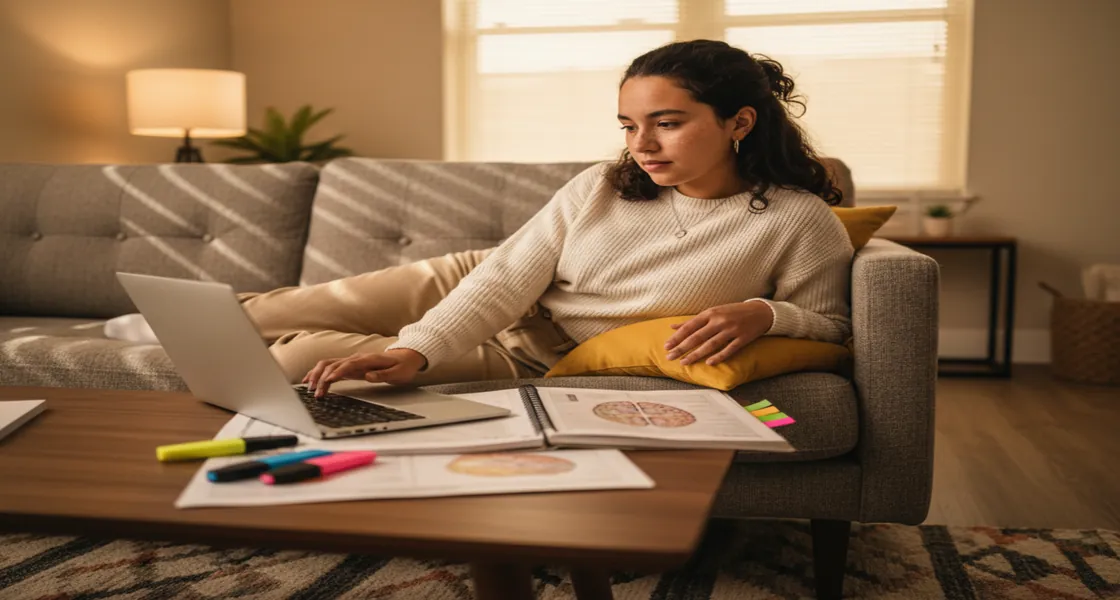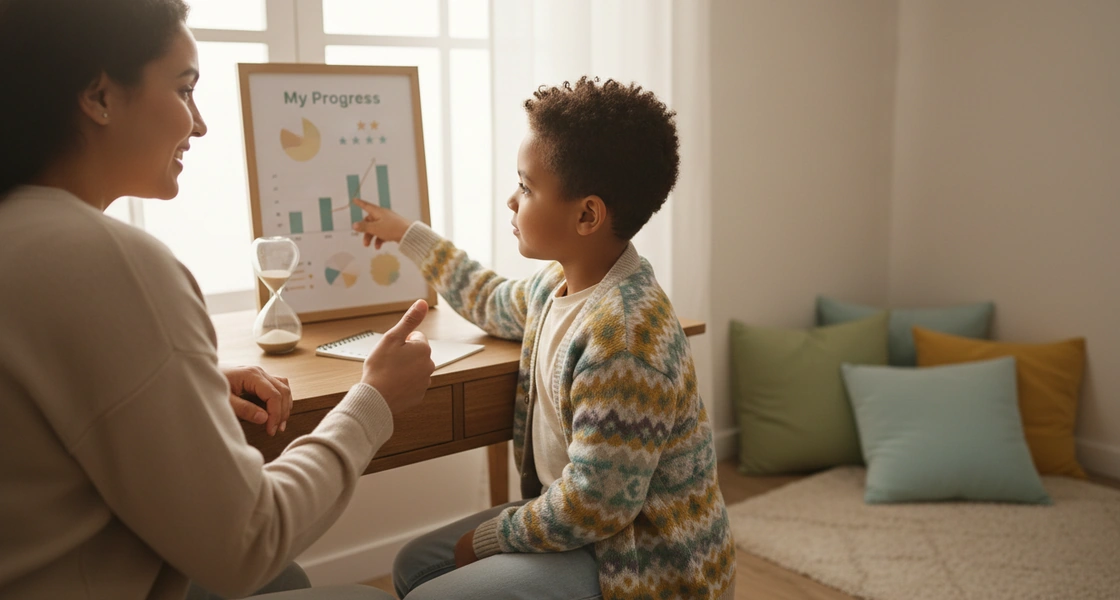Through multiplication, your learner might start to see numbers working together—in patterns, in groups, and all around their everyday world. But for many learners, moving from simple counting to multiplication can feel like a big leap.
In this guide, we'll share approachable ways to introduce multiplication at home. You'll find ideas for building a strong foundation, effective practice strategies, tips for working through common challenges, and ways to stretch into more advanced skills when your learner is ready.
Outschool offers small-group math classes and one-on-one tutoring that give your learner the chance to ask questions, build confidence, and make sense of multiplication in fun and approachable ways.
Building a strong foundation
Before your learner starts memorizing facts, it's important to show them what multiplication means. At its core, multiplication is just a faster way of repeatedly adding the same number. When your learner sees that connection, multiplication feels a lot less mysterious.
Here are a few playful ways to help build that foundation:
Equal groups
Grab some snacks, crayons, or markers, and invite your learner to create equal groups.
You might say, "Let's make four plates with three cookies each. How many cookies do we have?" By building and counting groups, learners naturally discover that multiplication is just repeated addition.
Arrays
An array is a way to show multiplication by arranging objects into rows and columns. Your learner builds several equal rows, each with the same number of items—then counts everything to find the total. This makes multiplication feel concrete and organized, and it helps your learner see how groups relate to each other.
Example:
Lay out 3 rows of 4 buttons each. Your learner can count one row at a time (4, 8, 12) or count all the buttons together. This models 3 × 4 = 12.
Arrays also make it easier to spot patterns, especially when building fact families like 2s, 5s, or 10s.
Number lines
A number line shows multiplication by moving forward in equal steps. Your learner starts at 0 and “jumps” forward by a set amount, repeating that jump a certain number of times to reach the product.
Example:
To solve 4 × 5, your learner starts at 0 and makes four jumps of 5: 0 → 5 → 10 → 15 → 20.
The final number, 20, is the answer.
Using number lines builds a strong connection between multiplication and skip counting, and helps your learner understand how repeated addition works visually.
Spotting patterns
Use a ‘hundreds chart’ or a color-coded number line to highlight multiples of 2, 5, or 10. Then, ask curious questions like, "Why do multiples of 5 always end in 0 or 5?" Noticing these patterns builds number sense and early problem-solving skills.
Linking addition and multiplication
Frame multiplication as a natural next step from addition: "We have five apples here, five apples there, and five more over here. Instead of adding 5 + 5 + 5, we can say we have three groups of 5, or 3 × 5." Connecting new ideas to familiar math can help your learner feel more confident.
Making practice meaningful
As your learner gets a feel for multiplication, practice can turn those early sparks into lasting skills. Offering different ways to explore multiplication keeps learning lively—and helps learners build flexible, confident thinking.
Move from objects to pictures to numbers (Concrete–Pictorial–Abstract)
This is a step-by-step approach to teaching math concepts, starting with real objects (concrete), moving to drawings or models (pictorial), and finally introducing numbers and symbols (abstract).
It helps your learner understand multiplication deeply by building meaning before memorization and abstract understanding.
- Concrete: Start with real objects like blocks, snacks, or toys. Let your learner group and count them.
- Pictorial: Invite them to draw groups or arrays—turning real objects into pictures.
- Abstract: When they're ready, introduce simple number sentences, like 3 × 4 = 12.
Moving gradually from hands-on to visual to symbolic thinking helps multiplication feel natural, not rushed or confusing.
Build multiplication charts together
Rather than handing over a completed chart, build it together, fact family by fact family.
As you fill it out, point out patterns: "Hey, every number in the 5s ends with 0 or 5!" Turning the chart into a shared discovery makes memorization feel more like solving a puzzle—and much more fun.
Turn practice into play
Short bursts of fun practice help multiplication facts stick without adding pressure. A few ideas to try:
- Multiplication Bingo: Create a simple board with products that learners need to find.
- Array scavenger hunts: Search the house for real-life arrays—egg cartons, window panes, muffin tins.
- Card flip challenges: Flip two cards and multiply the numbers.
- Multiplication hopscotch: Draw numbers on the sidewalk and solve problems with each hop.
Playful practice gives your learner space to explore, make mistakes, and build confidence without the pressure to "get it perfect" every time.
Building confident fluency
Once your learner has a strong foundation with hands-on activities and patterns, it's a great time to help them build fluency with multiplication facts. This stage aims to make recall easier and more natural, laying the groundwork for bigger problem-solving.
Start with easier fact families
A fact family is a group of related multiplication facts that share a common number pattern—for example, all the multiplication problems involving 2s (like 2 × 3, 2 × 5, and 2 × 7).
These families follow predictable rhythms that can make it easier for your learner to spot patterns.
Some good places to start:
- 0s: Any number times 0 is always 0.
- 1s: Any number times 1 stays the same.
- 2s: Doubles—naturally connected to skip counting by 2s.
- 5s and 10s: Numbers that end in 0s and 5s, making patterns easy to spot.
- 11s: Any double-digit of the same number (11, 22, 33)
Spending extra time here builds confidence before moving into trickier sets like 6s, 7s, 8s, and 12s.
Teach strategies alongside memorization
Rather than sticking only to repetition, introduce a few flexible strategies that help facts make sense:
- Doubling: If 2 × 6 = 12, 4 × 6 is double that, or 24.
- Using near facts: If 5 × 7 = 35, 6 × 7 is just another group of 7 (35 + 7 = 42).
- Breaking apart numbers: Solve 7 × 8 by considering it as (7 × 5) + (7 × 3).
- Skip counting: Build rhythmic patterns, like 2, 4, 6, 8 for 2s or 5, 10, 15, 20 for 5s.
Giving learners a few different strategies lets them figure out what makes the most sense to them, and helps them feel more confident solving problems their own way.
Use music, rhythm, and movement
Adding rhythm and movement brings energy and memory boosts to multiplication practice.
You might try:
- Singing skip-counting songs for 2s, 5s, and 10s
- Clapping or tapping a steady beat while reciting facts
- Creating simple chants or raps for trickier facts like 7s and 8s
Music and motion can make practice feel more like play, and help facts stick naturally.
Keep practice short and consistent
A few focused minutes a day often work better than long sessions. During these short bursts:
- Invite your learner to talk through their thinking
- Celebrate clever strategies, persistence, and creative problem-solving
- Treat mistakes as part of learning, not something to avoid
Keeping practice low-pressure and steady helps fluency grow without feeling overwhelmed.
Layer fact families gradually
As your learner becomes more comfortable, you can introduce new sets bit by bit:
- Add 3s, 4s, and 6s next, building on patterns they already know
- Then move into 7s, 8s, 9s, and 12s, using helpful strategies like:
- Thinking of 9 × 6 as (10 × 6) minus 6
- Breaking 12 × 4 into (10 × 4) + (2 × 4)
Taking it one layer at a time helps learning feel manageable—and keeps momentum steady.
Keep visual supports handy
Even as fluency grows, keeping multiplication charts, skip-counting strips, or fact family posters nearby is helpful. Visual tools within reach give your learner backup when needed and encourage independent problem-solving without pressuring them to "memorize everything" immediately.
Stretching multiplication thinking
Once basic facts feel comfortable, your learner might be ready to use multiplication in bigger, more meaningful ways. By layering in models, everyday examples, and pattern recognition, you'll help your learner stretch their thinking one step at a time.
Start with multi-digit multiplication using models
Larger multiplication problems can feel overwhelming at first, but breaking numbers apart makes them manageable. You can walk your learner through a problem like 23 × 4 by splitting it into parts (known as partial products):
- Solve 20 × 4 = 80
- Solve 3 × 4 = 12
- Then add the two parts together: 80 + 12 = 92
Drawing it out can help, too. Sketch a rectangle, divide it into sections labeled 20 and 3, and show the two smaller multiplications inside. Box diagrams and area models give learners a visual way to see how multiplication connects to addition and place value.
Connect multiplication to finding area
Real-world measurement is a natural next step for practicing multiplication. Invite your learner to explore the spaces around them:
- How many tiles cover the bathroom floor?
- How much space does the vegetable garden take up?
- How big is your drawing paper?
Using multiplication to measure real spaces helps learners see math as useful and something they're already involved in.
Notice and name multiplication properties naturally
As your learner works through bigger problems, they'll notice important patterns. You can strengthen their understanding by pointing these out casually during practice:
- Commutative property: 4 × 7 is the same as 7 × 4—the order doesn't change the result.
- Associative property: (2 × 3) × 4 is the same as 2 × (3 × 4)—grouping doesn't change the outcome.
- Distributive property: 6 × (4 + 2) can be solved by breaking it into (6 × 4) + (6 × 2).
There's no need to dive into formal definitions yet. Just noticing and naming these patterns builds the flexible thinking they'll need later.
Finding helpful resources
This collection is a great place to start if you're looking for ways to make multiplication practice feel fresh and engaging. You'll find games, activities, books, and flexible learning options that can fit your day in whatever works best for your family.
Games and activities for hands-on practice
Short, playful activities help learners build fluency without feeling stuck in drills. These games bring multiplication to life through action and exploration:
- Math Dice Junior (ThinkFun) — A simple dice game where learners create multiplication problems from rolled numbers.
- Multiplication Snap Cards — A fast-paced matching game that strengthens fact recall.
- Treasure Hunt Multiplication Game — Printable or homemade scavenger hunts using multiplication clues.
- Flip and Multiply Card Challenges — Flip two playing cards and multiply; add bonus twists using jokers or face cards.
Tools for visualizing multiplication
Seeing multiplication in action helps many learners organize their thinking and spot important patterns. These tools invite learners to build, arrange, and experiment:
- Reusable Multiplication Boards — Grids for building arrays with markers, stickers, or counters.
- Skip-Counting Number Lines — Visual aids that show 2, 5, or 10 jumps across a line.
- Mathigon Polypad — A free, interactive website for creating arrays, number lines, and area models.
You can also create simple visuals at home with stickers, building blocks, or sidewalk chalk!
Books that introduce multiplication naturally
For learners who enjoy reading or storytelling, these books weave multiplication into engaging narratives:
- Amanda Bean's Amazing Dream by Cindy Neuschwander — A story about seeing multiplication everywhere.
- Each Orange Had 8 Slices by Paul Giganti Jr. — A visual counting book that introduces multiplication ideas.
- Too Many Kangaroo Things to Do! by Stuart J. Murphy — A playful look at skip counting and early multiplication.
Reading about multiplication through storylines makes the concepts feel familiar and fun.
Structured programs for deeper practice
If you're looking for a curriculum to follow, these programs offer multiplication practice woven into broader math development:
- RightStart Mathematics Level C — A hands-on curriculum that uses visual models, games, and strategies to build strong skills.
- Math With Confidence: Second and Third Grade by Kate Snow — Gentle, parent-led programs with clear multiplication strategies.
- Beast Academy (Art of Problem Solving) — An engaging, story-based math curriculum that introduces multiplication through puzzles, comics, and creative problem-solving.
Each program balances hands-on learning, visuals, and structured lessons differently, so you can find the right fit for your learner.
Live and flexible learning options
Sometimes working with a teacher and hearing other learners' ideas brings fresh energy to multiplication practice. Outschool offers a variety of live and flexible courses designed to build skills in a supportive, playful setting:
Here are a few options on Outschool where learners can practice skills in a playful, interactive setting:
Live and flexible classes mix real-time guidance with playful learning, allowing learners to ask questions, share ideas, and practice independently. For even more game-based learning options, check out our Multiplication Games Collection.
Common questions and how to overcome them
When practice feels tough, a few questions tend to come up. It's a normal part of learning—every learner needs time, space, and support. Here's a closer look at some everyday struggles and ways you can help your learner.
What if my learner feels overwhelmed by memorization?
When memorizing facts starts feeling stressful, it's often a sign to slow down—not speed up. Rather than pushing through everything at once, focus on a smaller group of facts your learner is close to mastering. Working in smaller batches gives them time to feel successful and notice patterns without overloading.
What if my learner's confidence takes a dip?
If your learner starts feeling stuck or frustrated, it can help to zoom out and look at the bigger picture. Talk about what they've already learned and figured out—not just in math but across all kinds of learning. Sometimes, a reminder of their growth in other areas makes one tricky topic feel less overwhelming.
What if my learner rushes or guesses through problems?
Rushing usually means a learner is trying to "get through" rather than thinking it through. Instead of slowing them down by correcting them, try asking open-ended questions:
- "What did you notice about that one?"
- "Was there a pattern you were using?"
Questions like these can gently shift their focus to understanding without adding extra pressure.
What should I do if practice feels stuck?
If practice feels heavy or stuck, sometimes the best move is to change the environment, not just the task. Take practice outside, mix in drawing or storytelling, or step away and come back fresh. Small shifts like these can help reset the energy without making practice feel like a struggle.
Supporting your learner's next steps
The work you're doing to support your learner, showing up, being patient, trying different ways to make things click, can shape their learning experience. Every small step helps build thinking skills, confidence, and the sense that challenges are something they can handle. And whenever you want a little extra support, Outschool's live classes and tutoring options are here to offer more tools, more ideas, and more ways to keep growing together.


.svg)
.svg)







